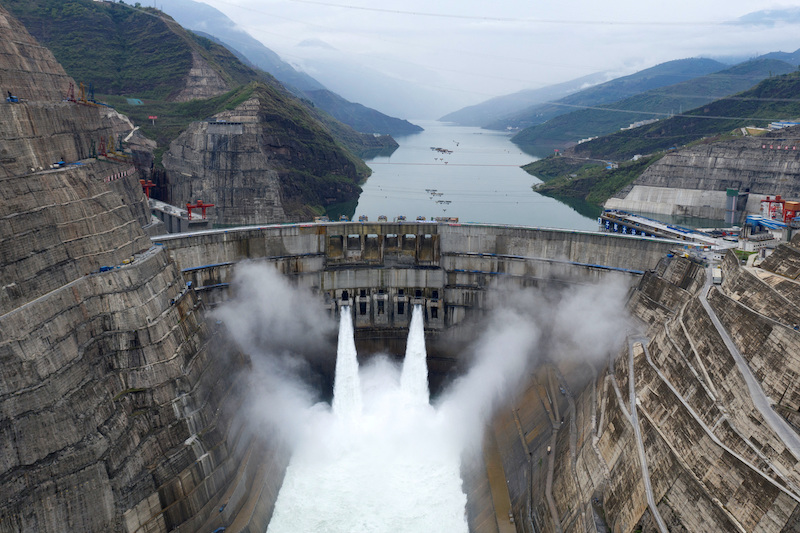A plunge in power generated by dams and hydro-plants in China and India has forced Asia’s two biggest polluters to rely more on electricity from coal and other fossil fuels.
Asia’s hydropower output fell by close to 18% during the seven months through to July this year, data from energy think tank Ember showed, while fossil fuel-fired power rose 4.5%.
That is the fastest fall in hydropower output in decades. Hotter, plus more extreme and erratic weather was partly the reason for this, and it has made also created problems for power regulators because it creates more volatile electricity demand.
These problems are significant in China and India, which account for about three quarters of Asia’s power generation and most of its emissions. They have been using renewable power sources to make up for some of the hydropower shortfall, but are also seeking to meet rising electricity use.
ALSO SEE: China Sees Calls for Deep Reform, Others Urge More Spending
Intense heatwaves, less rainfall
Major Asian economies have faced power shortages in recent years due to extreme weather conditions, including intense heatwaves and lower rainfall over large swathes of northern China and Vietnam, as well as in India’s east and the north.
Higher use of polluting fuels such as coal to meet electricity demand spikes and supply shortages underscore the challenges of lowering emissions.
“Despite a strong growth in solar and wind power generation in Asia, supply from fossil-fuel thermal power plants has also increased this year as a result of a large decline in hydropower generation,” Carlos Torres Diaz, Rystad Energy’s director of power and gas markets, said.
“Intense and prolonged heatwaves across the region have resulted in low reservoir levels and the need for alternative sources of power to help meet demand,” he added.
China hydropower down 16% this year, drier weather
China’s hydroelectricity generation during the eight months ended August declined at the sharpest rate since at least 1989, falling 15.9%, an analysis of National Bureau of Statistics data showed.
In India, hydropower generation fell 6.2% during the eight months ended August in the sharpest decline since 2016. Its share of power output plunged to 9.2%, the lowest in at least 19 years, according to an analysis of government data.
China made up for the hydro shortfall and higher power demand mainly by increasing electricity generation from fossil fuels by 6.1% in the eight months through August, while India boosted fossil fuel-fired power output by 12.4%, data showed.
Renewable output grew by 22% in China and 18% in India during the same period, data showed, but from a far smaller base.
Hydropower output also plunged in other major Asian economies including India and Vietnam, as well as the Philippines and Malaysia, data from Ember and the International Energy Agency showed, mainly due to drier weather.
In Vietnam, hydropower’s share of power output fell by more than 10 percentage points through July, while coal’s share grew by about the same amount, Ember data showed.
In some cases, the hydropower output plunge was a result of efforts to conserve water and alter supply patterns.
‘China using hydropower to balance grid’
Lauri Myllyvirta, lead analyst at the Centre for Research on Clean Energy and Air, said Chinese authorities pushed dam operators to maintain water levels as power consumption spiked due to heatwaves.
Hydropower can be ramped up and down in a short time to address sudden demand fluctuations, unlike other sources such as wind and solar. Myllyvirta said authorities used it more to balance the grid instead of maximising generation.
“This trend of rapidly increasing wind or solar power generation in China could push for hydropower playing this critical regulating function, instead of operating whenever there is water,” he added.
Asian power generation from wind and solar increased 21% in the seven months to July, Ember data showed, rising to 13.5% of overall output from 11.5% a year earlier.
However, unlike hydro, wind power is harder to forecast and control, as it varies by local weather conditions. And the unavailability of solar at night exacerbates shortfalls in countries including India.
India has cut daytime power outages to nearly zero this year despite record demand, mainly because of its renewables build-up over the years. Still, it was forced to seek imports of more expensive natural gas in a bid to reduce pressure on its coal power fleet.
“The main utility of hydro is to support wind and solar. If hydro itself becomes unreliable, India may have to think of alternatives including addition of more coal-fired power,” Victor Vanya, director at power analytics firm EMA Solutions, said.
- Reuters with additional editing by Jim Pollard
ALSO SEE:
China’s Shift to Renewable Energy Roaring Ahead – Guardian
Global Warming Set to Break 1.5C Tipping Point by 2027
India’s Power Play to Become a Global Solar Force – Hindu
Vietnamese Fret Over US Xinjiang Law Risk to Solar Panel Trade
Solar Power Saves India $4.2 Billion in Fuel Costs – Mint
























